DTF printing is taking off for at-home users, but there are a lot of people wondering is DTF printing safe? Here are some at-home DTF printing safety precautions that you should take every time you use your printer.
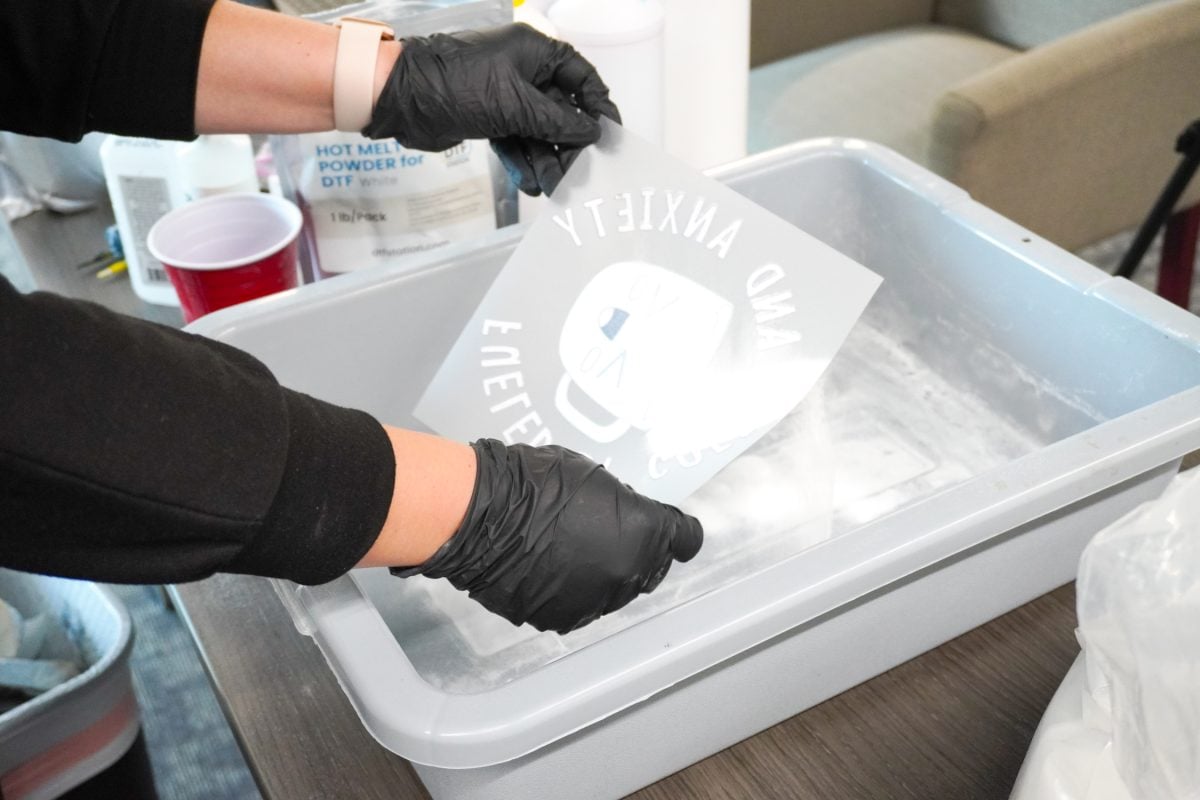
DTF (direct-to-film) printing is taking the crafting world by storm. There are several companies that offer smaller DTF printers designed for home or small business use (see my review of the Prestige A4) which means that more and more everyday crafters and small businesses are jumping on the DTF train.
But with this new printing technology come a lot of safety concerns that I don’t think we as an industry are taking seriously enough. This includes my own content on DTF printing so far. When I learned to use a DTF printer, we took some safety precautions, but I want to expand upon those in this post.
I’ve spoken with some professionals and others who are taking the safety concerns seriously. I will caveat all of this by saying I am not a doctor, scientist, or a safety professional. Any DTF crafting you do is done at your own risk, even with the precautions I talk about in this post.
Watch the Video
Want to see me go over all of these tips in a video? Just hit play below! Or keep reading for a written explanation.
What’s So Great About DTF Printing?
Why do we even go to the trouble to do DTF printing if there are safety concerns? To be frank, DTF transfers are awesome.
They fill in a gap in between other transfer types. They are full-color, unlike most HTV, and require no cutting or weeding. They can be used on any color and most types of fabric, unlike sublimation which requires a lighter colored fabric and a polyester count of 65% or higher. DTF printers are generally less expensive than white toner printers (which give you similar results) and lots of companies are starting their own custom DTF transfer businesses so they are easy to order online.
For me, they allow me to easily and quickly make shirts in way that just so much slower and more tedious with other methods. Pressing a DTF transfer is super easy and the results last 50 to 100 washes when applied properly.
And I can use my favorite brand of shirts, BELLA+CANVAS. I really love sublimation printing, but after a while, I wanted to be able to use cotton and dark colors. When I started ordering DTF prints, I realized I could really dig into my BELLA+CANVAS stash and make shirts that are so much softer and more breathable than polyester shirts. Not to mention I could use their full range of colors!

Did you know you can buy BELLA+CANVAS garments at wholesale pricing without a reseller license? Get a BELLA+CANVAS Maker’s Account! This account allows you access to the wholesale side of their business without the need for any permits or licenses. Even better? It’s free! Learn more in my post Buying Wholesale Blanks without a Resale License!
So DTF printing is awesome and I think the technology is going to improve and hopefully become more safe in the next few years (and I think the costs will come down). But we definitely need to talk about why DTF printing can be unsafe and what we can do to mitigate the risks.
Pressing DTF Prints
Most of my readers will only be ordering DTF prints and pressing them at home. The risk here is much lower than having a DTF printer in your home, where you would be working with wet inks and powdered and melted adhesives.

If you’re just pressing DTF prints, the primary precaution you want to take is increasing ventilation in your workspace. An open window with a fan blowing out and an air purifier work well together to increase air flow and reduce any fumes. This is the same as working with a sublimation printer or a laser machine and is generally easy to do for almost all crafters.
What Makes DTF Printing Unsafe?
Now let’s talk about safety for those of you who have an at-home DTF printer or are thinking about getting one. There are a few primary things that make the process of printing, powdering, and curing a DTF print unsafe.
For any products, you can always go looking for their safety data sheet, like this example for the the DTF powder I used with the Prestige A4.
Some inks and powders may say they are certified safe and nontoxic, but most things are not healthy to breathe in. For example, water is nontoxic, but if you breathe it into your lungs, you’re going to feel terrible or worse. Just because the TPU powder is formaldehyde free, for example, doesn’t mean we want it coating our lungs.
And if you read forums and on YouTube comments, you’ll see people who have all sorts of symptoms from not taking any precautions when working with DTF supplies (including cancer), so let’s err on the side of caution.
Solvent Ink
Solvent ink is used in DTF printing. Unlike the ink used in everyday printers, solvent inks can release Volatile Organic Compounds (VOCs) which are harmful to breathe in. They may make you feel dizzy, give you a headache, or irritate your eyes. These inks can also irritate your skin.
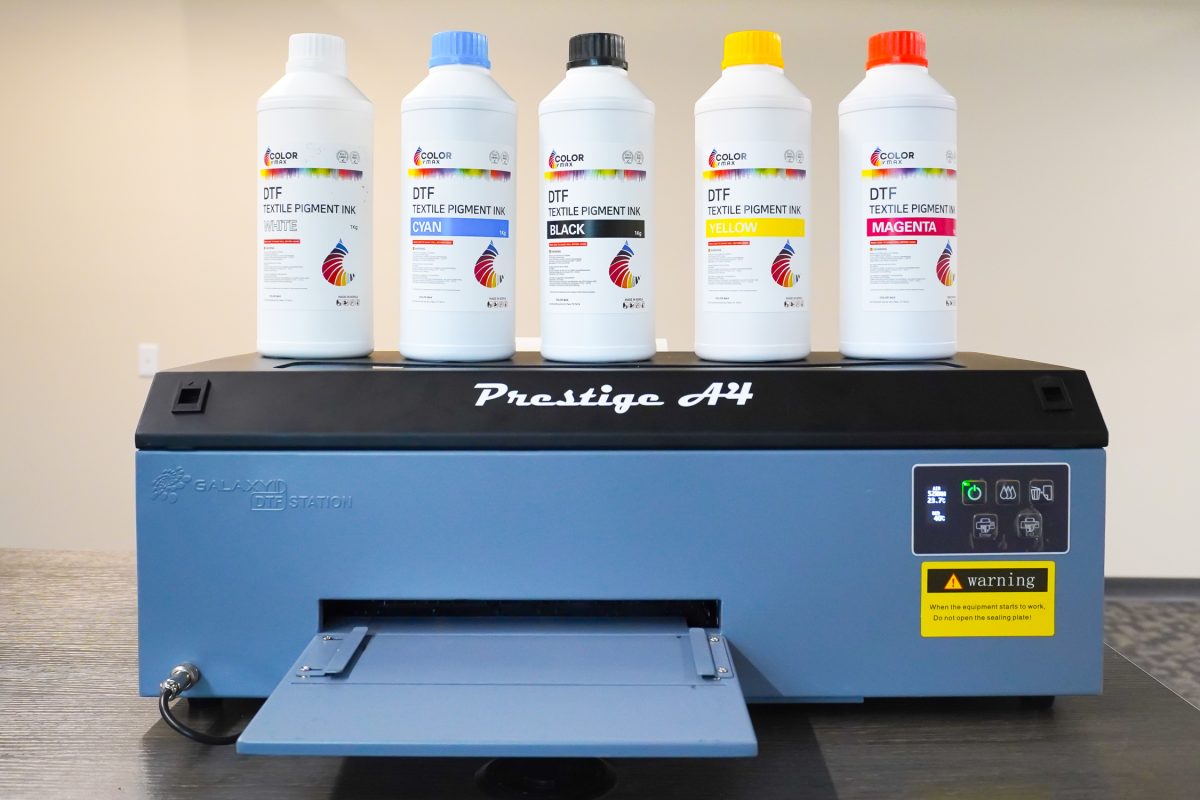
Note that a mask doesn’t help with these fumes—they go right through because the particles are too small. You’ll want to see the ventilation section below, as well as the PPE section to avoid the solvent inks in your eyes or on your skin.
TPU Powder
The adhesive used in DTF printing is a thermoplastic polyurethane (TPU). This is a microplastic—the same thing that we see warnings about in our oceans, foods, and even our bodies. You do not want to be breathing in plastics! The effects of exposure to microplastics hasn’t been fully studied, especially for kids and pets.

TPU powder is like fine sheetrock dust. And if you’ve ever had wall or plaster work done in your house, it will spread like sheetrock and plaster dust. It can be a nightmare.
Which means that TPU powder is nearly impossible to contain when using a DTF printer at home. You’ll want to basically take all the precautions below to help minimize how much TPU powder ends up where you don’t want it.
Curing Transfers
The curing process is a third place where you will find chemical compounds you don’t want to be breathing in, including isocyanate compounds. Basically you’ll need to use an oven to melt the TPU powder to the back of your transfer and during that process, chemical compounds are released. These compounds can be very irritating to your eyes, your lungs, and your gastrointestinal tract.
I see many at-home crafters using a heat press to cure DTF prints they’ve done a hacked printer. Other than trying to increase ventilation, there’s no way to contain these fumes. This is why I always recommend getting a curing oven and changing the filter regularly.
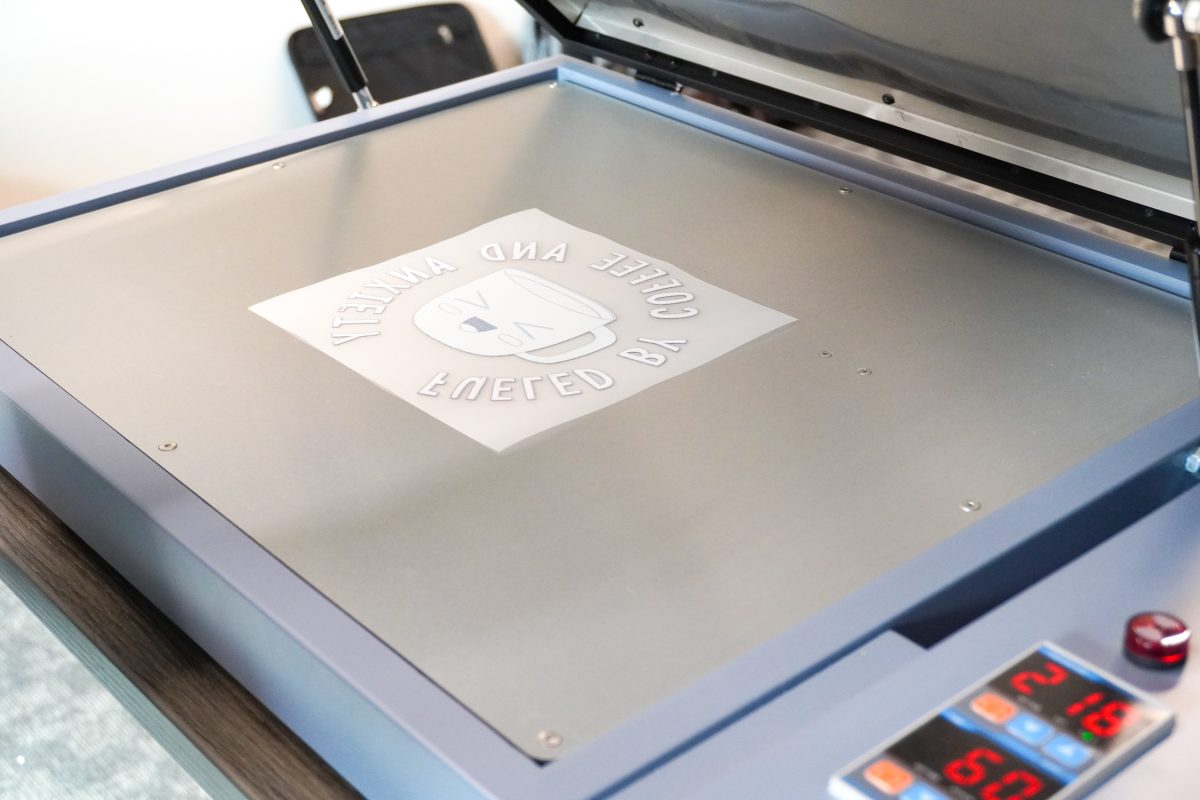
DTF Printing Safety Precautions
Here’s how we can limit most (but probably not all) of the risks of DTF printing at home.
Equipment
There is a combined piece of equipment that can really help contain the harmful substances we’re talking about here. I haven’t tried it myself (since the DTF printer I was using is not mine), but I think it looks really promising.
The Miro 13 is a combined powdering and drying/curing machine. It basically combines the hand-powdering and DTF curing oven into a single machine with HEPA and charcoal filtration. You can connect it directly to your Prestige A4, meaning that as you print, your prints are automatically fed into the Miro 13 and finished for you.
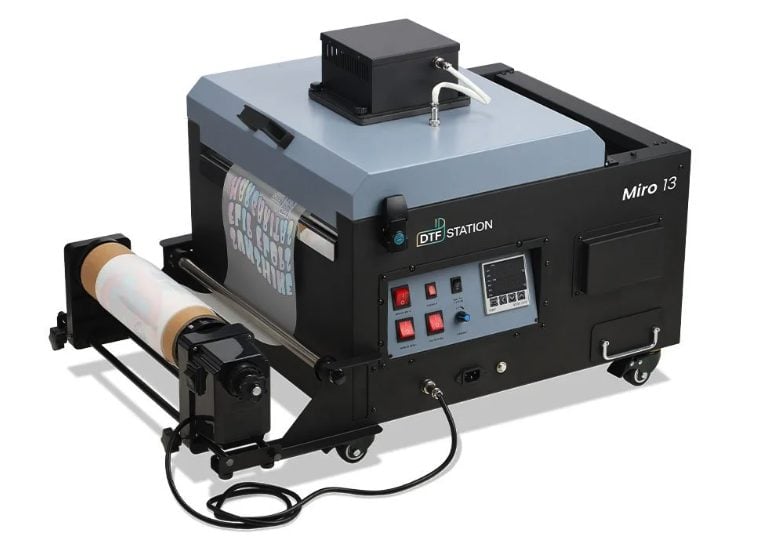
This drastically reduces the amount of TPU powder and fumes that are just floating around in your space. You will still need to load the machine so the amount of powder escaping into the air is not zero, but it’s a lot less than it would be with the hand-powdering method. While filling the machine, wear PPE as described below.
And in addition to being safer, it reduces the amount of space you need for DTF printing and of course reduces the mess.
Of course, this is an investment and not cheap (around $2000 in addition to the printer), but if you are doing DTF printing at home with something like the Prestige A4, you really may want to consider how much your health is worth.
You can also get a curing oven separately.
Ventilation
I talked about ventilation for pressing DTF prints you’ve ordered, but we need to take ventilation to another level if you’re printing at home. High volume ventilation is going the be the biggest thing you can do to limit your exposure.
The baseline is a high-quality box or floor fan (set to high) in a window blowing air out. You can add one blowing in as well, creating a cross breeze. Open your other windows and doors too if you’d like.
But my best advice is to do your DTF printing in your garage or shed—somewhere that limits the amount of powder and fumes that may work their way into your home. Open the garage or shed door and have a that powerful fan blowing air out. Think of it similarly to a woodshop where you’re creating a lot of fine particle wood dust. You don’t want to breathe that in either!
With the fan, you want to be able to feel a breeze in your craft space. An air purifier is good, but not strong enough to create that air flow. So combine that air purifier with a fan. The goal is if the powder gets in the air, that the fan will blow the powder outside instead of it going into your lungs or getting tracked into other parts of your home.
Access
You’ll also want to limit access to your DTF printing area, especially for children and pets. A lock on the door and/or locking up your TPU powders and solvent inks so that no one can access them but you.
PPE
You’ll also want to wear your personal protective equipment. Start with a tight-fitting N95 mask (a surgical mask is not good enough—the sides are not tight-fitting). An N95 should catch most if not all powder particles so you aren’t breathing them in. Ink solvent fumes and curing fumes are pretty much impossible to contain, so work on your ventilation to minimize those risks.
Add eye protection that includes a gasket or seal around the edge so the powder and chemical compounds do not get into your eyes. And wear disposable gloves to protect your hands.
For clothing, wear either a disposable lab gown or clothes that you designate for DTF printing only. One thing I wish I’d added when I was testing the DTF printer was a disposable hair cover. The powder definitely settled into my hair which mean that I was tracking it into parts of the house where I didn’t want it.
Once you’re done DTF printing, clean your workspace really well. Then make sure you shower and rinse of any powder that may have settled on other parts of your body.
Isn’t This Overkill?
Honestly, I don’t think so. The more I’ve learned about having an at-home DTF printer, the more concerned I’ve become with the safety risks, particularly when it comes to kids. Exposing yourself and forgoing precautions is one thing. You’re making that choice. But when it comes to your kids—they aren’t making that choice and their lungs are still developing. Don’t risk their health (or your health!) by minimizing the risks with “oh, everything will be fine!”
I think about it like asbestos. One-off exposure to TPU powder is most likely not going to cause any long-term damage to your body. But repeated exposure where your body doesn’t have time to expel it is where you are going to have issues. My grandpa actually died due to lung issues caused by asbestos and I don’t want to see that fate for anyone doing DTF printing without the proper safety precautions.
I hope you found this video on DTF printing safety helpful and not too scary! While there’s no way to eliminate every single risk (there really isn’t any way to do this in most things), you can significantly lower the risk to you and your family when doing at-home DTF printing.
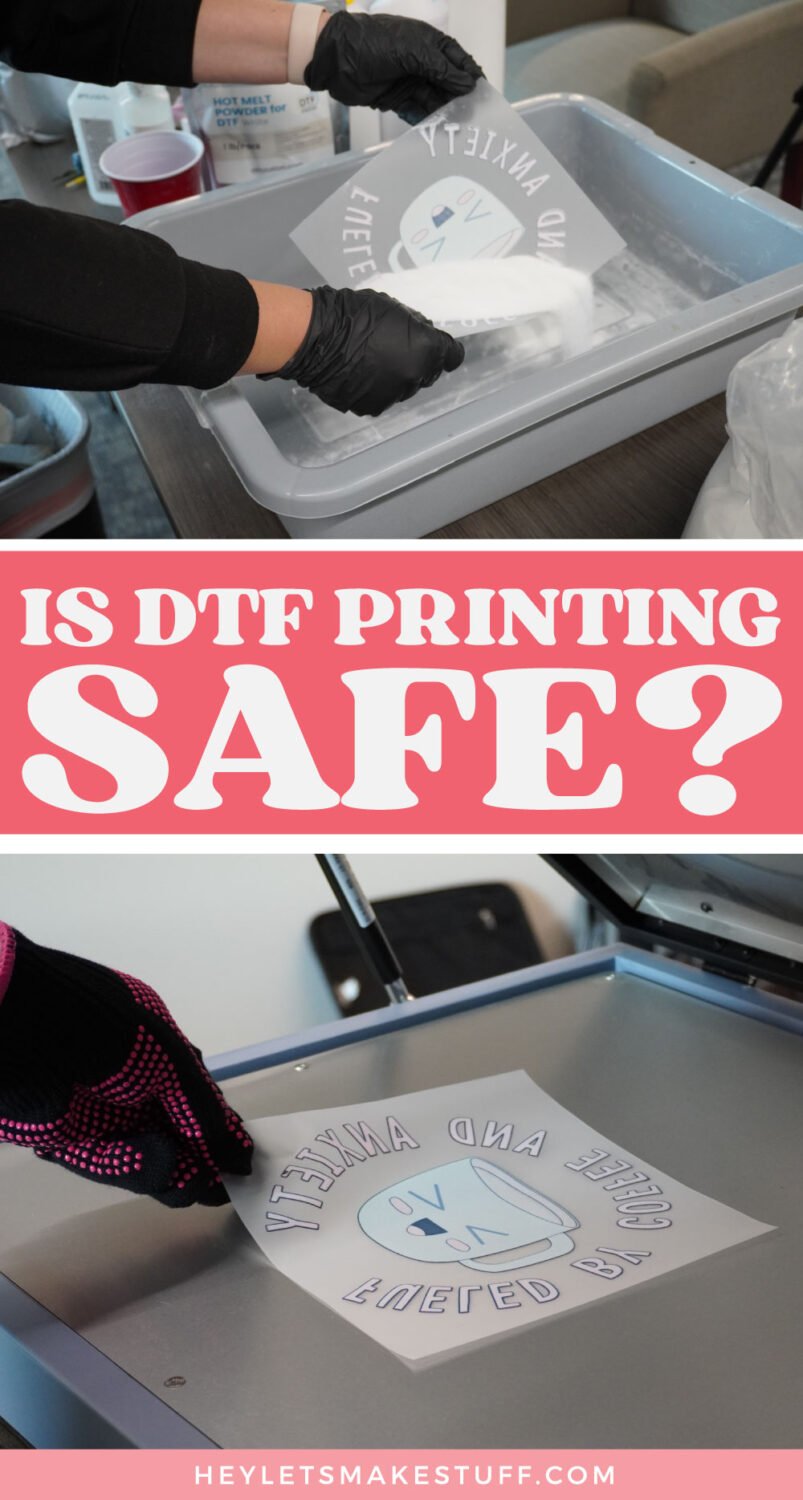
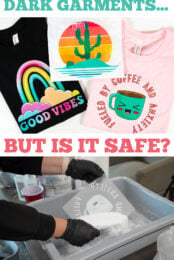
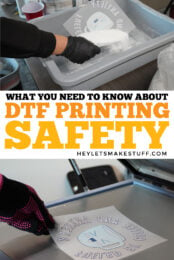
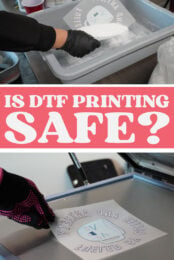


Comments & Reviews
Muhammed Yusuf Yilmaz says
All the information you shared with us is very helpful for my business. Thanks